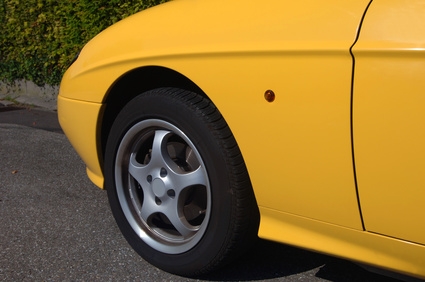
The rear wheel bearing system of the Hyundai Tiburon is a very simple system. Using drum brakes, Hyundai designed the bearings and bearing races to be inserted into the brake drum hub. This cuts down on the number of parts and reduces the difficulty of replacing the rear bearings. Using minimal tools, this job can be completed from home in less than two hours.
Park the vehicle on a flat, dry surface. Turn off the engine and gather all the necessary tools.
Roll a floor jack under the rear of the vehicle and jack it up far enough to insert a set of jack stands. Lower the vehicle down onto the jack stands and ensure the vehicle is safely supported.
Remove the lug nuts from the rear wheels with a lug nut wrench and pull off both rear wheels. Remove the anti-lock speed sensor if your vehicle is equipped with it. The sensor is the only component with a wire harness going to it at the rear wheel brake area. Remove the bolt that secures the sensor with a ratchet and socket.
Pry off the axle nut cap with a flathead screwdriver. Be careful not to damage the cap. Once the cap is removed, you will see the axle nut with a cotter pin through it. Remove the cotter pin with a pair of pliers. Then remove the nut with a ratchet and socket.
Pull on the brake drum to remove it from the brake assembly. Once the drum is removed, push the outer bearing out of the drum.
Remove the inner bearing seal and bearing by pulling them off by hand. Remove the bearing races from the brake drum by tapping them out with a hammer and drive.
Lay out the new bearings and bearing races for installation. Start with both bearing races. Using a drive and hammer, carefully insert the new races into the brake drum.
Cover the bearings and the inside of the hub with bearing grease. Slide the inner bearing over the axle shaft and follow it up with the inner bearing seal. Be sure there is plenty of grease on these parts.
Push the drum brakes over the brake assembly. Make sure it is pushed back all the way. Install the new outer bearing by pushing it in. Hold it with one hand and then thread the axle nut onto the axle shaft. Tighten the nut with a torque wrench to the manufacturer's specifications. Install a new cotter pin onto the nut and bend over the excess cotter pin with pliers. Clip off excess cotter pin with side cutters. Put the axle nut cap over the nut and tap it in with a plastic hammer.
Reattach the anti-lock brake sensor and tighten the retaining bolt with a ratchet and socket. Put the rear wheels back on and tighten the lug nuts with a lug nut wrench.
Raise the vehicle enough to pull out the jack stands. After they are clear, lower the car back down to the ground.